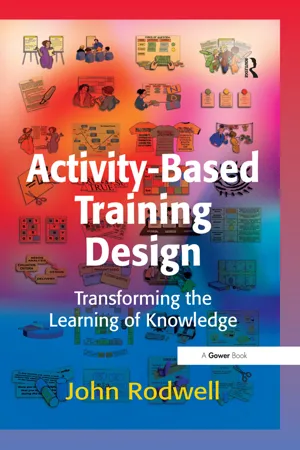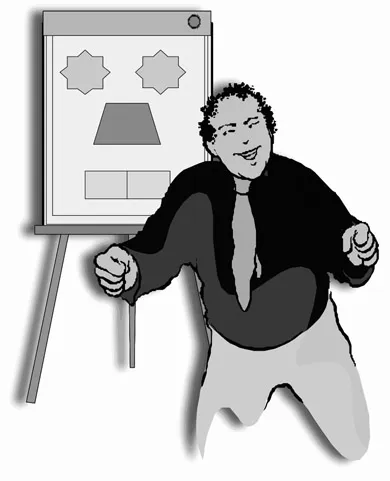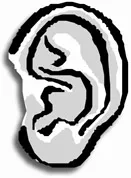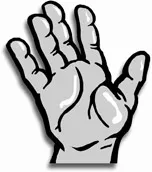One of the main reasons why activity-based methods work is that they are fun! Another is that they appeal to a range of different senses, and subsequently appeal to individuals’ different learning styles.
The Fun Factor
Training is a serious business. A lot of money is either spent or invested (depending on your point of view) in it and it has to produce results and measurable benefits for the organization otherwise you might as well not bother at all and spend (or invest) your money on something else.
However, although it is agreed that training is a serious business, it does not mean that you have to be dour and miserable as you do it. It doesn’t mean that you can’t have any fun or enjoyment while you are learning. Indeed I am sure that most scholars and adult learning experts would agree that a relaxed and open environment is almost a prerequisite of effective learning.
The activity-based training methods described in this book have been designed to be enjoyed not just by the participants but also by the learning facilitator or trainer.
The serious side to the issue is that the training must also do its job. It must facilitate the learning of the knowledge and skills needed by the people who are on the receiving end, which must in turn lead on towards the appropriate application in the workplace, and the required organizational outcomes.
I have known people come back from training events who have said something like ‘It was great fun and I learned a lot’. This is how it should be. I have also known people on the other hand who have returned from training events saying: ’It was so boring! I didn’t learn a thing!’ This is obviously unacceptable. Also unacceptable, however, is the type of training where someone comes back and says: ’Didn’t learn anything really, but it was great fun!’
The term ‘serious fun’ has been coined for the development of computer-based training that works like a computer game and captures the interest and imagination of people in just the way that computer games do. I believe that the same term can be applied to classroom and any other kind of training.
Learning Styles
The methods described in this book also promote learning in the way that they can appeal to different senses, and thus different learning styles.
Within the neuro linguistic programming (NLP) school of psychology, the concept of individuals having certain ‘modalities’ is put forward. A modality can be described as being the way that you perceive and take on board information most easily. According to NLP principles, there are three main learning modalities. These are visual, auditory and kinaesthetic.
Visual
If you have a preference for visual learning, you will prefer to learn through seeing and using your eyes. Here are a few other attributes of visual learners:
- They will remember what they see rather than what they hear or touch or feel.
- They prefer written instructions to verbal (and may therefore write verbal instructions down).
- They will memorize things by making visual associations.
- They are not easily distracted by noise.
Auditory
If you have a preference for auditory learning, you will prefer to learn through hearing and using your ears. Here are a few attributes of auditory learners:
- They will remember what was discussed more than what was seen or touched or felt.
- They can remember and follow verbal instructions easily.
- They are better at talking than writing.
- They can remember not only things that were said, but also their tone and pitch.
- They are easily distracted by noise.
Kinaesthetic
If you have a preference for kinaesthetic learning, you will prefer to learn through moving, doing and touching. Here are a few attributes of kinaesthetic learners:
- They will remember the manipulation and movement of objects.
- They can memorize by pacing around and seeing.
- They like games they can get involved in.
- They respond to physical rewards and prizes.
- They like to act things out.
According to strict NLP psychology, there are two other modalities: olfactory (smell) and gustatory (taste). Whilst not impossible to promote learning through these two senses in a classroom environment, it is not so easy, and there are not very many people who naturally learn best through either of these senses.
When you start to look at the activity-based methods in this book, you will see that many of the activities appeal to at least two of these modalities, if not all three at the same time. Here is one example from each type of activity described in this book:
Missing bullet points (active reading)
- Reading/checking for the right place – visual.
- Discussing with others – auditory.
- Cutting and/or pasting – kinaesthetic.
Washing line (card sort)
- Seeing different colours, shapes and graphic text – visual.
- Discussing with others/listening to instructions – auditory.
- Handling the different shaped items and pegging onto the line – kinaesthetic.
What am I? (games and activity boards)
- Seeing coloured cards and graphic text, watching demonstrations – visual.
- Listening to verbal clues and descriptions, listening to demonstrations – auditory.
- Handling of cards, moving and acting out the demonstrations – kinaesthetic.
Accelerated Learning
The methods described in this book also comply with many of the principles of Accelerated Learning, a movement which fortunately seems to be getting more and more of a foothold into organizational learning and training.
Here are some of the Accelerated Learning principles with which I believe the activity-based methods in this book comply:
Use of all the senses
As described above with the NLP learning modalities.
Positive learning environment
The methods promote a relaxed yet engaging learning environment along with moments of childlike excitement and feelings of achievement when activities are completed.
Collaboration
All of the activities can be carried out by small groups working in collaboration.
Variety
The activity-based methods are of sufficient number to allow for a variety of activities just using them alone. Further variety can be added, however, through the use of more traditional participative and presentational methods.
Working with the brain
The human brain thrives on being stimulated through things like colour, movement, texture, shape, rhythm, sounds and so on. The brain also works better with imagery rather than words. People will remember more about the activities and their content because there is more to trigger their recall.
***
As yet I have no scientific proof that Accelerated Learning or activity-based training enables people to learn more than any other methods. However, even if there was absolutely no difference between the amount of learning achieved through the new methods and the old methods, and the only difference was the amount of enjoyment and fun experienced by the participants, I know which methods I would prefer, both as participant and trainer!
The Training Cycle
The concept of the training cycle model shown in Figure 2.1 will not be new to most trainers. It is the basic model for the provision of training. In essence, the training cycle plots the development processes required to produce effective training and is often seen as progressing in four distinct stages.
- You identify the needs.
- You design the training to meet the needs.
- You deliver what you have designed.
- You evaluate the results.
...




